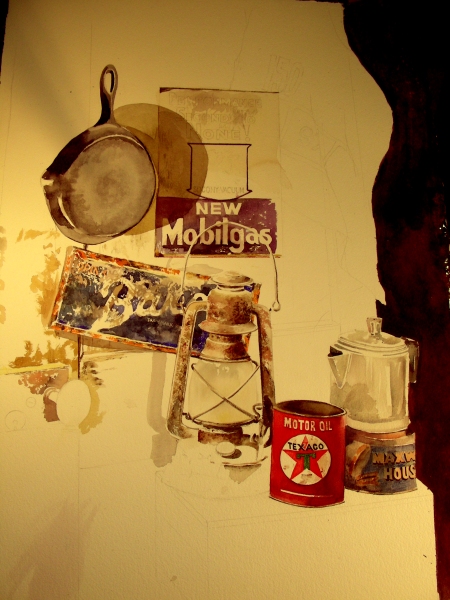An artist learns by repeated trial and error, by an almost moral instinct, to avoid the merely or the confusingly decorative, . . . to say what he has to say with the most direct and economical means, to be true to his objects, to his materials, to his technique, and hence, by a correlated miracle, to himself.
Irwin Edman, Arts and the Man
I found an amazing thread of continuity among some of the divines I’ve been reading lately: Ian Roberts, Ezra Pound, Ernest Hemingway and Andrew Wyeth. Each in his own way addressed the notion of getting at a subject directly and honestly, with no decorative scrollwork. Hence my recent interest in creating “vignette” compositions with my watercolors, leaving plenty of undefined boundaries so the viewer can have imaginative room to enter the composition. Ezra Pound and William Carlos Williams addressed this in literary fashion with their “Imagism” theories. Andrew Wyeth addressed it when he said the strength of a composition is not what the artist puts into the picture, but what s/he leaves out. Hemingway, during his early years of writing in Paris, acknowledged that he created his best work when he cut out all the ornamental prose as so much scrollwork, and returned to the truest sentence that always began his writing. And so, in recent sketches and compositional studies, I have been creating simpler works of art, and plan to do that when I get to the Gulf later.
Another theme I am trying to work out is that which involves the boundary or tension between two features. I’ve been reading Paul Tillich this week, fascinated with his focus on the littoral zone separating ocean from beach, and how he continually applied this to his studies in philosophy, theology, art and psychology. He once wrote that “the border line is the truly propitious place for acquiring knowledge.” I have always enjoyed working this idea in my philosophy and art history classes, but now wish to push it in my own theories of aesthetics as I pursue my watercolor attempts.
In closing, I’m going to post this crayon drawing I dug out of my closet last night when I was foraging for watercolor paper for my next project. I didn’t know I still had it: the earliest “work of art” from my personal collection. When I was in third grade, my teacher entered this drawing in the districtwide art contest, grades 1-12. I still remember entering the high school gymnasium and seeing my matted work hung on the wall among hundreds and hundreds of student works of art. If the Presocratics and Aristotle were right in saying “the end is in the beginning,” then perhaps I ought to look at this one more closely and see if I recognize any of my own features in it.
Thanks for reading.
I paint in order to remember.
I journal when I feel alone.
I blog to remind myself that I am not alone.













